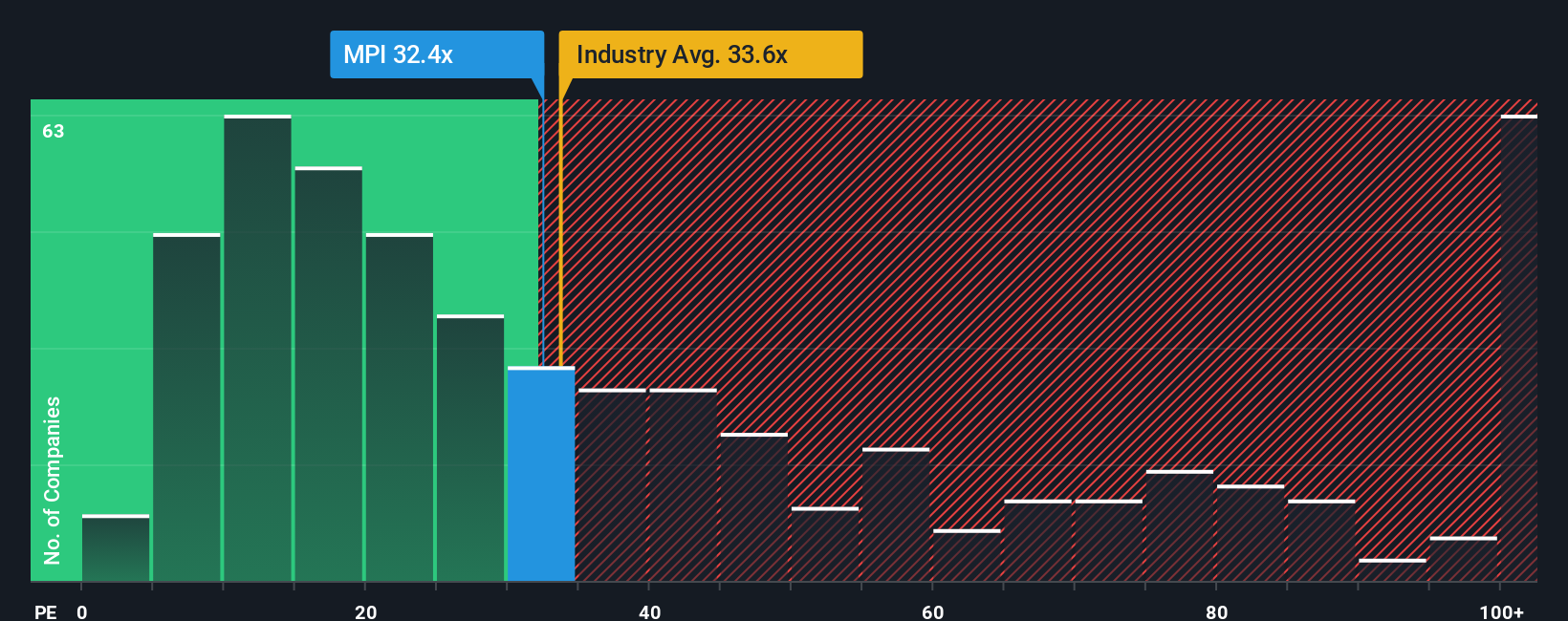- Malaysia
- /
- Semiconductors
- /
- KLSE:MPI
Malaysian Pacific Industries Berhad's (KLSE:MPI) P/E Is Still On The Mark Following 30% Share Price Bounce
Malaysian Pacific Industries Berhad (KLSE:MPI) shareholders have had their patience rewarded with a 30% share price jump in the last month. Unfortunately, the gains of the last month did little to right the losses of the last year with the stock still down 30% over that time.
After such a large jump in price, Malaysian Pacific Industries Berhad may be sending very bearish signals at the moment with a price-to-earnings (or "P/E") ratio of 32.4x, since almost half of all companies in Malaysia have P/E ratios under 14x and even P/E's lower than 8x are not unusual. Nonetheless, we'd need to dig a little deeper to determine if there is a rational basis for the highly elevated P/E.
Malaysian Pacific Industries Berhad hasn't been tracking well recently as its declining earnings compare poorly to other companies, which have seen some growth on average. One possibility is that the P/E is high because investors think this poor earnings performance will turn the corner. You'd really hope so, otherwise you're paying a pretty hefty price for no particular reason.
See our latest analysis for Malaysian Pacific Industries Berhad

What Are Growth Metrics Telling Us About The High P/E?
Malaysian Pacific Industries Berhad's P/E ratio would be typical for a company that's expected to deliver very strong growth, and importantly, perform much better than the market.
Taking a look back first, the company's earnings per share growth last year wasn't something to get excited about as it posted a disappointing decline of 6.6%. As a result, earnings from three years ago have also fallen 53% overall. Therefore, it's fair to say the earnings growth recently has been undesirable for the company.
Looking ahead now, EPS is anticipated to climb by 18% per year during the coming three years according to the seven analysts following the company. Meanwhile, the rest of the market is forecast to only expand by 12% each year, which is noticeably less attractive.
With this information, we can see why Malaysian Pacific Industries Berhad is trading at such a high P/E compared to the market. It seems most investors are expecting this strong future growth and are willing to pay more for the stock.
What We Can Learn From Malaysian Pacific Industries Berhad's P/E?
Malaysian Pacific Industries Berhad's P/E is flying high just like its stock has during the last month. Using the price-to-earnings ratio alone to determine if you should sell your stock isn't sensible, however it can be a practical guide to the company's future prospects.
We've established that Malaysian Pacific Industries Berhad maintains its high P/E on the strength of its forecast growth being higher than the wider market, as expected. Right now shareholders are comfortable with the P/E as they are quite confident future earnings aren't under threat. It's hard to see the share price falling strongly in the near future under these circumstances.
The company's balance sheet is another key area for risk analysis. Take a look at our free balance sheet analysis for Malaysian Pacific Industries Berhad with six simple checks on some of these key factors.
Of course, you might find a fantastic investment by looking at a few good candidates. So take a peek at this free list of companies with a strong growth track record, trading on a low P/E.
New: Manage All Your Stock Portfolios in One Place
We've created the ultimate portfolio companion for stock investors, and it's free.
• Connect an unlimited number of Portfolios and see your total in one currency
• Be alerted to new Warning Signs or Risks via email or mobile
• Track the Fair Value of your stocks
Have feedback on this article? Concerned about the content? Get in touch with us directly. Alternatively, email editorial-team (at) simplywallst.com.
This article by Simply Wall St is general in nature. We provide commentary based on historical data and analyst forecasts only using an unbiased methodology and our articles are not intended to be financial advice. It does not constitute a recommendation to buy or sell any stock, and does not take account of your objectives, or your financial situation. We aim to bring you long-term focused analysis driven by fundamental data. Note that our analysis may not factor in the latest price-sensitive company announcements or qualitative material. Simply Wall St has no position in any stocks mentioned.
About KLSE:MPI
Malaysian Pacific Industries Berhad
An investment holding company, engages in the manufacture, assemble, test, and sale of integrated circuits, semiconductor devices, electronic components, and lead frames in Asia, the United States, and Europe.
Excellent balance sheet and overvalued.
Market Insights
Community Narratives





